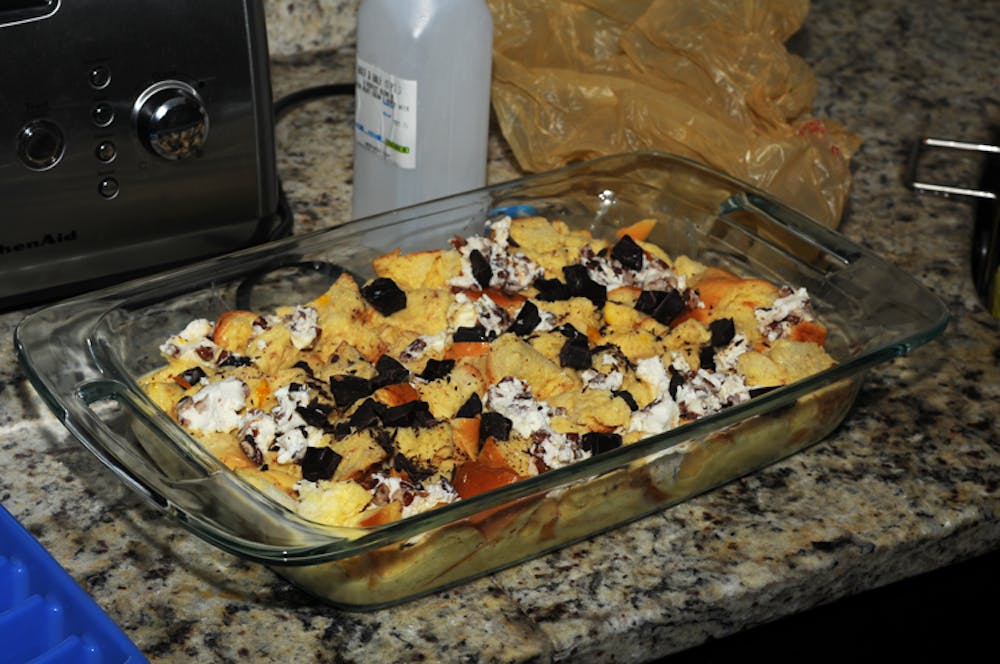If you want to get off CampusFood and into the kitchen, Street wants to help — and we’re going all out for this one. We enlisted the services of one Nikki Hill, former sous chef at Barbuzzo and current co–owner of La Copine, a catering service that hosts a weekend Brunch Cart. Nikki knows her stuff, but that’s not why we chose her. She does things sort of like a college student would. We asked her for an ingredient list ahead of time, but Nikki insisted on winging it. We let her, and here’s what we learned.
Our goals
1 meal (entree, side, dessert) 2 hours (one for shopping, one for cooking, and you don’t have to do them both the same day) Less than $40 All from Fresh Grocer (Nikki vetoed this, check below for three reasons to hit the Farmers’ Market) 4 hungry happy people
Why We Picked the Farmer's MarketClark Park Farmers’ MarketSimplicity: It’s called a Supermarket for a reason — places like FroGro have everything, and when you have just an hour or two to throw a meal together, perusing a 21–aisle grocery store isn’t going to make things any easier. At the Farmers’ Market, it’s what’s in season or bust. Plus, you won't find any flashy signs to tempt you, or nutrition labels to dishearten you. Quality: When something’s grown locally, it’s going to taste better and be better for you. Think about it logically — when your yield is smaller, and you don’t have to worry about transcontinental shipping, it’s easier to focus your attention on the product. These guys are experts — the Farmers’ Market is the ultimate mom 'n’ pop. As Breadriot.org so aptly put it, going there is “like going to Best Buy and having Steve Jobs there to help you buy an iPod.” Efficiency: Sure, there is something seemingly fast–tracked about pushing wheeled carts through a store with more signage than I–95. Or maybe you live on the North side of campus, and the walk to FroGro seems a lot shorter than crossing Locust, Spruce AND Pine. If it really does reduce your time to hit the grocery store, we’re all for it, but getting to the Farmers’ Market isn’t as tough as you think: it’s a nice walk, you won’t find any lines and if you forget something, you don’t have to bribe the person behind you to let you run and grab it. Overall, we found the experience a lot less stressful.
Blocks from campus: 5 Number of vendors: 7 Number of food groups not represented: 0 Ingredients picked up (by stand):
Pork kielbasa ($6.50) Butternut squash, small pepper, handful of radishes, onion ($3) Kale, mixed herbs — mostly sage and oregano ($3) Two Goldrush apples ($2.20) Loaf of challah, dozen cage–free eggs, edge of goat cheese with pecans ($6.50)
*We like Clark Park, but it’s not the only farmers' market in town. Want to buy your goods elsewhere? See 34st.com.
Nikki’s plan Pork kielbasa seared in red wine Kale, butternut squash and apple hash with radish and sage Challah bread pudding with dark chocolate, pecans and goat cheese All prepared with locally sourced, fresh ingredients Less than 45 minutes of prep/cooking time
Where we cheated (Street likes honesty) A detour to Milk & Honey (45th and Baltimore) for half & half and garlic: 10 minutes, $6 ($21.20 + $6.00 = $27.20, $12.80 short of our budget) Things we had beforehand: Sugar, butter, cinnamon, olive oil, red wine*, dark chocolate* (from my own stash), gin (cooking, like all other things, is less fun sober), the pan and baking dish, a cutting board, a wooden spoon, a kitchen *You don’t need this
The kielbasa: Nikki seared these sausages quickly, splitting the casings beforehand and cooking them in the red wine we were drinking. We didn’t have butter, so she spooned out a bit of our Earth Balance — she scoffed, we were more than pleased.
The hash: No, not the kind you can smoke. Nikki began by sauteing chopped onion in olive oil. From there, she added the remaining ingredients in layers (squash, kale, apple, radish and sage). This piecemeal process allows individual flavors to incorporate; Nikki recommends it for sauteing several vegetables in one dish.
The pudding: Think French Toast, but in the oven. After slicing the Challah into cubes and assembling them in a glass baking dish, Nikki prepared a custard of eggs, half–and–half, sugar, cinnamon and a pinch of salt. She poured this over the bread and sprinkled chocolate pieces and crumbled goat cheese on top before placing it in the oven for an hour at 425°. Nikki thought this came out a little dry, so go big on the custard.
Want to get your chef hat on? You need these five things in your kitchen:
1. Searing pan 2. Sharp, high–end knife (it’s worth the investment) 3. Saucepan 4. Good cutting board 5. Wooden spoon
Nikki’s advice:
1. Place a cloth under your cutting board so it doesn’t slide. 2. When chopping oddly–shaped things — like butternut squash — remove ends first. Flat edges make things easier to balance — it’s physics, right? 3. Improvise! If you like the looks of that rutabaga but haven’t the faintest idea of how to use it, buy it anyway. Even great chefs use Google. 4. Buy vegetables in advance and chop them when you have free time. “That way,” said Nikki, “if I wake up and want an omelette, I don’t have to start slicing peppers.” 5. Have a good soundtrack and lots of booze on hand. Like anything else, cooking is better when you’re comfortable.







